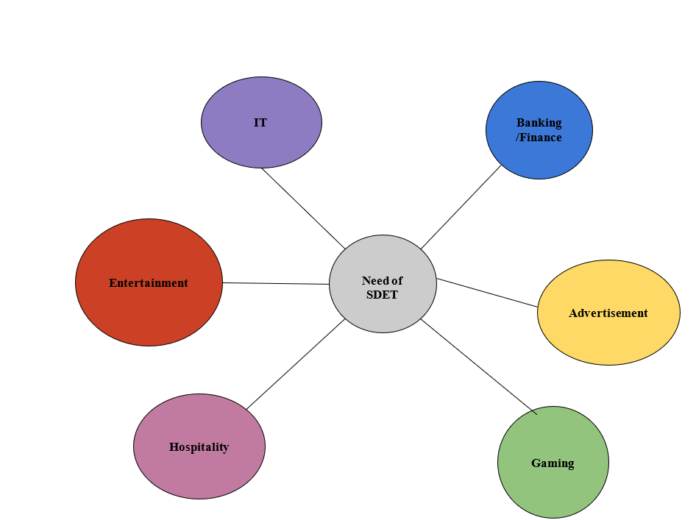In today’s competitive software development industry, the role of a Software Development Engineer in Test (SDET) has become increasingly important. As the name suggests, an SDET is a professional combining software development and testing skills. In this post, we will discuss the full form, meaning, role, and responsibilities of an SDET, covering all aspects of this critical position.
Full Form and Meaning
The full form of SDET is Software Development Engineer in Test. The term “Software Development Engineer” refers to an individual who is responsible for designing, developing, and testing software applications.
The addition of “in Test” indicates that this individual is specifically focused on testing and quality assurance. In essence, an SDET is a software engineer who is responsible for ensuring that the software meets the required standards and is free from defects.
Role of an SDET
An SDET plays a crucial role in the software development process, working closely with developers, product managers, and quality assurance teams to ensure that the software meets the required standards.
The primary responsibility of an SDET is to design, develop, and execute automated test cases to ensure that the software is robust, scalable, and meets the requirements of the end-users.
SDETs are also responsible for identifying and reporting defects, collaborating with developers to resolve issues, and ensuring that the software is thoroughly tested before release.
Responsibilities of an SDET
An SDET responsibilities can be broadly categorized into three main areas: testing, development, and collaboration.
Testing Responsibilities
As a tester, an SDET is responsible for designing and executing automated test cases to ensure that the software meets the required standards. This includes:
- Developing and maintaining test plans and test cases
- Creating and executing automated tests using various testing frameworks and tools
- Identifying and reporting defects, and collaborating with developers to resolve issues
- Ensuring that the software is thoroughly tested and meets the required standards
Development Responsibilities
As a developer, an SDET is responsible for designing and developing software applications, including:
- Designing and developing test automation frameworks and tools
- Developing and maintaining software applications using various programming languages and technologies
- Collaborating with developers to resolve issues and improve the overall quality of the software
Collaboration Responsibilities
As a collaborator, an SDET is responsible for working closely with various stakeholders, including:
- Developers: Collaborating with developers to resolve issues and improve the overall quality of the software
- Product Managers: Working with product managers to ensure that the software meets the required standards and meets the needs of the end-users
- Quality Assurance Teams: Collaborating with quality assurance teams to ensure that the software meets the required standards and is thoroughly tested
Difference between SDET and tester
| Differences in | SDET | Tester |
| Role and Responsibilities | Combines development and testing skills, develops automated tests, works with development teams. | Primarily tests software to find defects and bugs. |
| Skills and Expertise | Strong in software development, programming, and testing methodologies. | May lack programming expertise, focuses on manual testing. |
| Focus | Develops automated tests, ensures software quality, works closely with developers. | Identifies defects and bugs, less involved in the development process. |
| Career Progression | More challenging path, can advance to senior roles or management. | Can progress to senior tester roles or quality assurance manager. |
| Job Demands | Requires programming, testing knowledge, and good communication skills. | Needs strong testing knowledge, attention to detail, and analytical skills. |
Key Skills and Qualifications
To be successful in the role of an SDET, an individual should possess the following key skills and qualifications:
- Strong programming skills in languages such as Java, Python, or C++
- Experience with testing frameworks and tools such as Selenium, Appium, or JUnit
- Knowledge of software development methodologies such as Agile or Scrum
- Strong analytical and problem-solving skills
- Excellent communication and collaboration skills
Conclusion
In conclusion, the role of an SDET is a critical one in the software development industry. As a professional who combines the skills of both software development and testing, an SDET plays a vital role in ensuring that software applications are robust, scalable, and meet the required standards.
With the right skills and qualifications, an SDET can significantly contribute to developing high-quality software applications.
Some Questions
What is SDET?
SDET stands for Software Development Engineer in Test or Software Design Engineer in Test. It’s a role that combines software development and testing skills.
What are the responsibilities of an SDET?
SDETs are responsible for designing and developing test automation frameworks, creating test cases, and ensuring the quality of software products.
What skills do I need to become an SDET?
To become an SDET, you should have a strong background in software development, testing, and programming languages like Java, Python, or C++. Knowledge of testing frameworks, Agile methodologies, and version control systems like Git is also essential.
What are the benefits of hiring an SDET?
SDETs can help organizations improve the quality of their software products, reduce testing time, and increase efficiency. They can also help identify defects early in the development cycle, reducing the overall cost of testing.

















